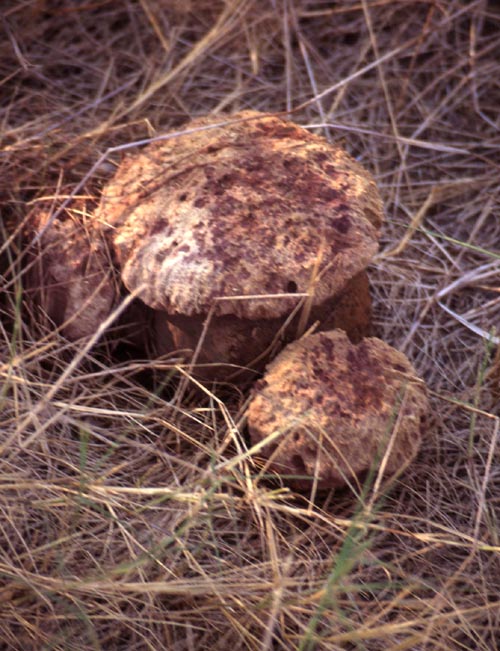
Puffballs are one kind of reproductive body of a group of fungi
called the Basidiomycota. The basidiomycotes also include fungi that
produce reproductive bodies that we call mushrooms. The reproductive bodies
are responsible for producing spores. Puffballs release millions of tiny
spores into the atmosphere. The spores travel considerable distances before
settling to earth. Spores germinate to produce another fungus.
Fungi are very different from other organisms that you are familiar with. The body of a fungus is composed of a large number of thin tubes called hyphae. The hyphae are all interconnected, so the cells of the fungus can communicate with one another (e.g. fungi are truly multicellular). The walls of the hyphae are made of chitin, which is the same material as in insect exoskeletons. A mass of hyphae is called a mycelium, which is the main part of the body of the fungus this is the white stuff you see when you break open a rotten log, or the mass of white or green stuff on rotting strawberries. Fungi are absorptive heterotrophs, and the hyphae first secrete enzymes onto their substrate, then absorb the material that is digested by the enzymes. Thus fungi are important decomposers, but they are also important pathogens, both of humans and of our crop plants, when we are serving as their substrates.
Fungal reproduction is even stranger than their way of life. In the
Basidiomycota, a germinating spore produces what is called a "primary
mycelium". The primary mycelia are either male or female, and the cells
of the hyphae are haploid (they have only one member of each of the homologous
pairs of chromosomes). These primary mycelia grow, but to reproduce they
have to join with another primary mycelium of the opposite sex. When a
male fungus meets a female fungus, they merge hyphae to form a secondary
mycelium. However, only the cytoplasm of the cells in the secondary mycelium
merges (the process of merging cytoplasm is called plasmogamy); the nuclei
remain separate and haploid. So a secondary mycelium is like a male and
a female living together in the same body but keeping their genetic material
separate. These are called "dikaryotic" hyphae, to distinguish them from
truly diploid cells (where the two sets of chromosomes merge into a single
nucleus). Most of the body of a basidiomycote fungus is a dikaryotic mycelium.
However, parts of the body become specialized for sexual reproduction.
These are the puffballs (or mushrooms). Inside the puffball, the nuclei
of some cells merge (this process is called karyogamy) to form diploid
nuclei. These diploid nuclei then immediately undergo meiosis to produce
haploid spores, starting the whole process over.